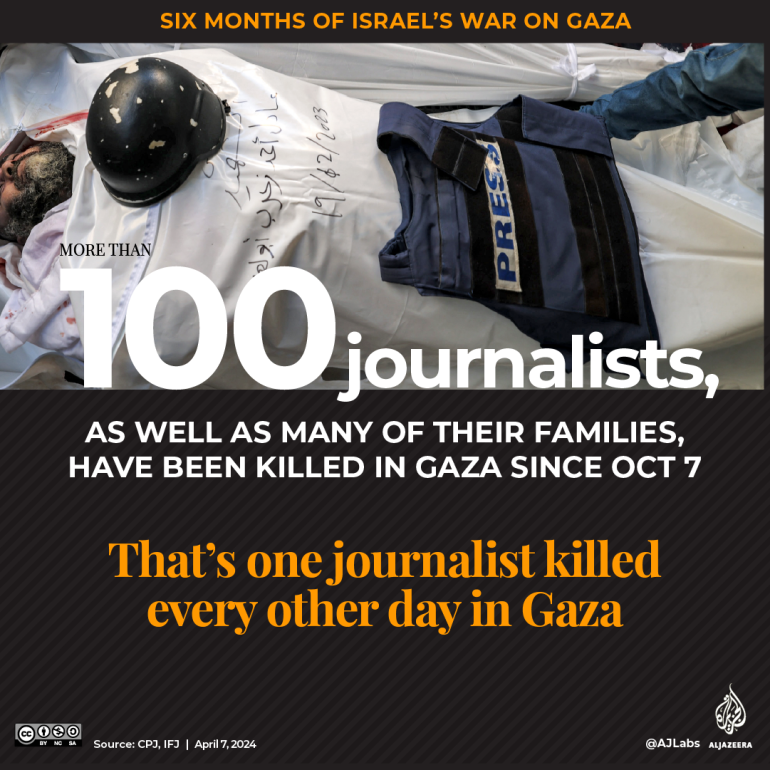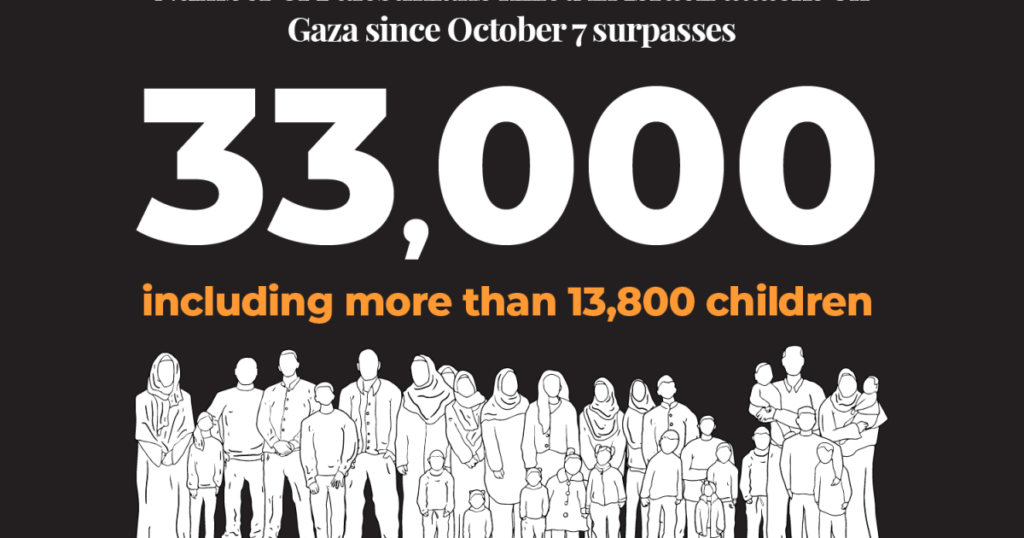Six months have passed since Israel launched its brutal attack on the Gaza Strip on October 7th.
Israel shows no signs of stopping as its allies continue to provide it with political support as well as more weapons to use against the Palestinians, and brokered talks have not resulted in a ceasefire.
Israel says the war in Gaza is in retaliation for attacks on Israeli territory from Gaza by armed groups led by Hamas's Qassam Brigades, which killed 1,139 people and captured about 250.
Look at the toll Israeli attacks have taken on Gaza.
How many people were killed or injured?
At least 33,137 Palestinians have been killed by Israeli forces in Gaza since the start of the war on October 7, according to the Gaza Health Ministry.
Thousands more are missing under the rubble of collapsed buildings and infrastructure and are presumed dead.
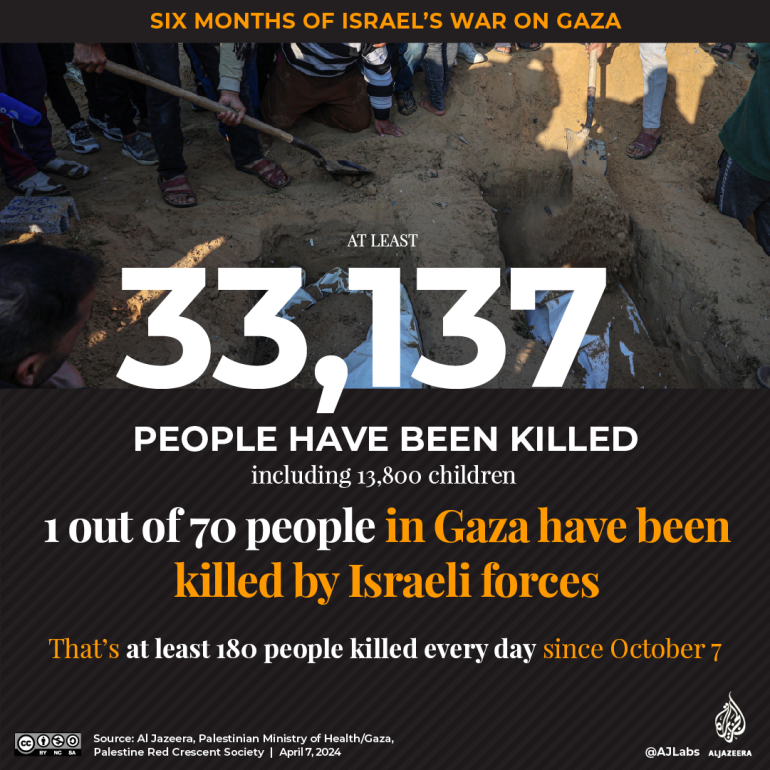
The vast majority of those killed were children and women, with Save the Children saying more than 13,800 children had been killed.
UNICEF, the United Nations fund for children, estimates that at least 17,000 Palestinian children are currently unaccompanied or separated from their parents in Gaza.
At least 75,815 people have been injured in Israeli attacks since the start of the war, roughly 4 for every 100 people in the Gaza Strip.
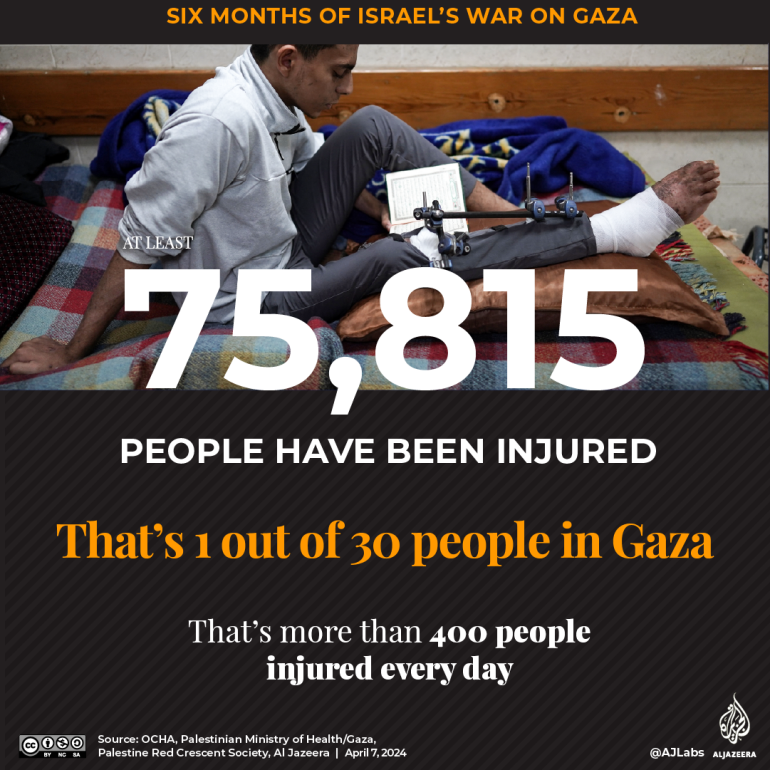
The Palestinian Red Crescent Society announced this week that around 1,000 children in the Gaza Strip have lost one or both legs.
Israel's relentless attacks continue to kill dozens of people every day.
Are people starving?
The humanitarian situation in Gaza deteriorated significantly in 2024 as the Israeli military blocked the arrival of aid and effectively imposed starvation as a weapon of war.
Almost all of the 2.3 million people trapped in Gaza are now facing hunger, and the United Nations has announced that hunger will be widespread in many parts of Gaza by May.
Northern Gaza, which was the first to be destroyed by Israel's ground invasion, was the hardest hit. Israel continues to severely restrict access to the north, blocking routes and subjecting aid convoys to delays and cancellations.
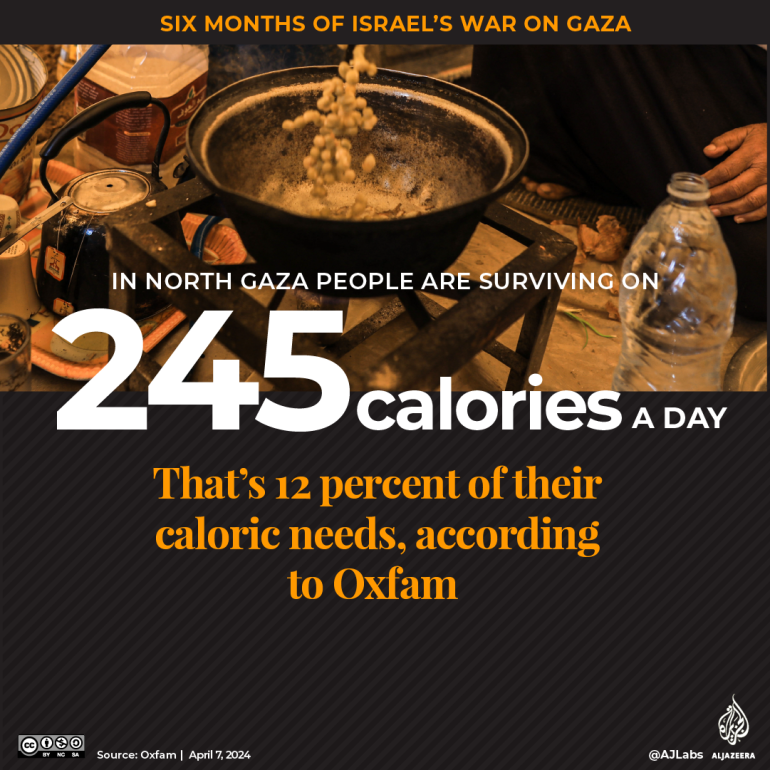
Infants and young children are dying from dehydration and malnutrition in northern Gaza, but Israel continues to block many humanitarian efforts.
Last week, Israeli forces deliberately killed seven foreign aid workers in three consecutive attacks on a 2.3-kilometer (1.4-mile) convoy, forcing some aid groups to cease operations.
How many people were evacuated?
From the start of the war, the Israeli military ordered Palestinians to “move south” as ground forces invaded Gaza from the north.
No one has been able to return to their homes in northern Gaza since then, as Israel set up a military corridor dividing the strip in half.
Approximately 1.9 million people, more than 80% of Gaza's population, are internally displaced. Most have taken refuge in UN facilities such as schools and hospitals, but still more than 400 people have been killed and at least 1,400 injured in these locations.
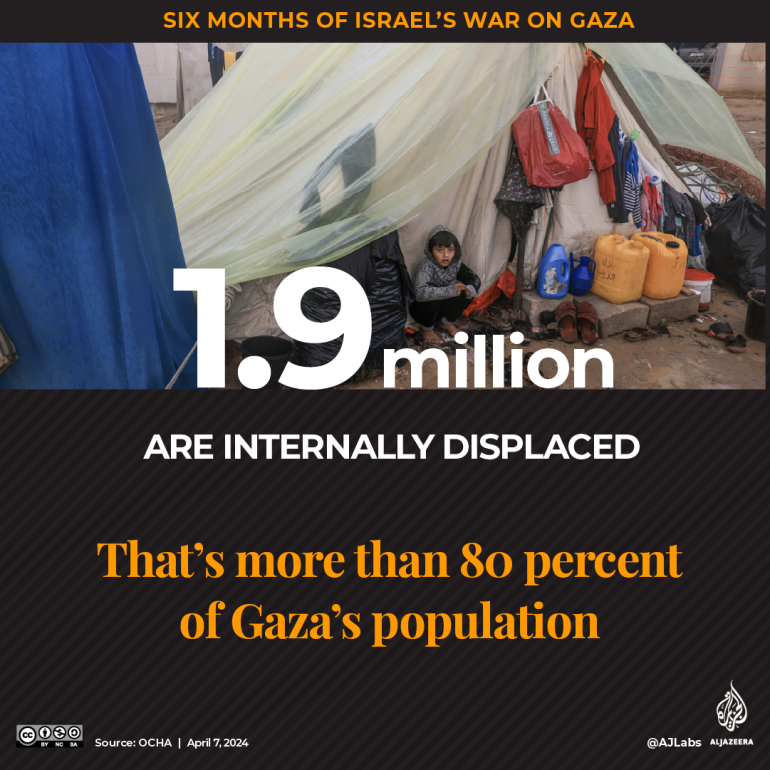
More than 1.5 million people are currently crammed into Rafah, Gaza's southernmost city on the border with Egypt. Many are forced to stay in makeshift camps or on the streets, exposed to Israeli air attacks.
Israel claims it will also invade Rafah by land.
The United Nations Palestine Refugee Agency (UNRWA) said more than 350 Israeli military attacks targeted buildings in the country, with 161 facilities damaged. Since October 7, a record 176 UN staff have been killed in Gaza.
How much of Gaza is in ruins?
The war has damaged or destroyed approximately 62 percent of all housing in Gaza (290,820 homes), leaving more than 1 million people homeless.
The World Bank and United Nations estimated $18.5 billion in damage to public service infrastructure, with destruction leaving behind 26 million tons of rubble and rubble.
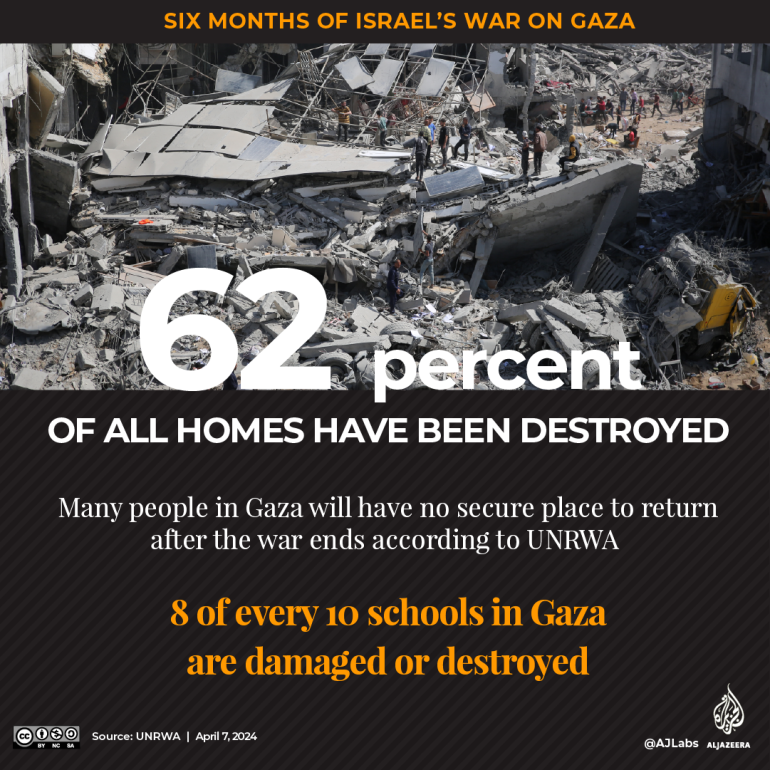
The worst-hit city was Khan Yunis in southern Gaza, where thousands of homes and infrastructure were destroyed in ground and air strikes as part of Israel's fight against “terrorists.”
According to UNICEF, eight out of 10 schools in Gaza have been damaged or destroyed. 625,000 students are without access to education.
Are hospitals functioning?
Israeli forces have focused attacks on hospitals across Gaza, claiming that Hamas operates inside and underground, even though they are protected by international law.
All hospitals have suffered significant damage, with only 10 out of 36 able to function partially, but overload is increasing.
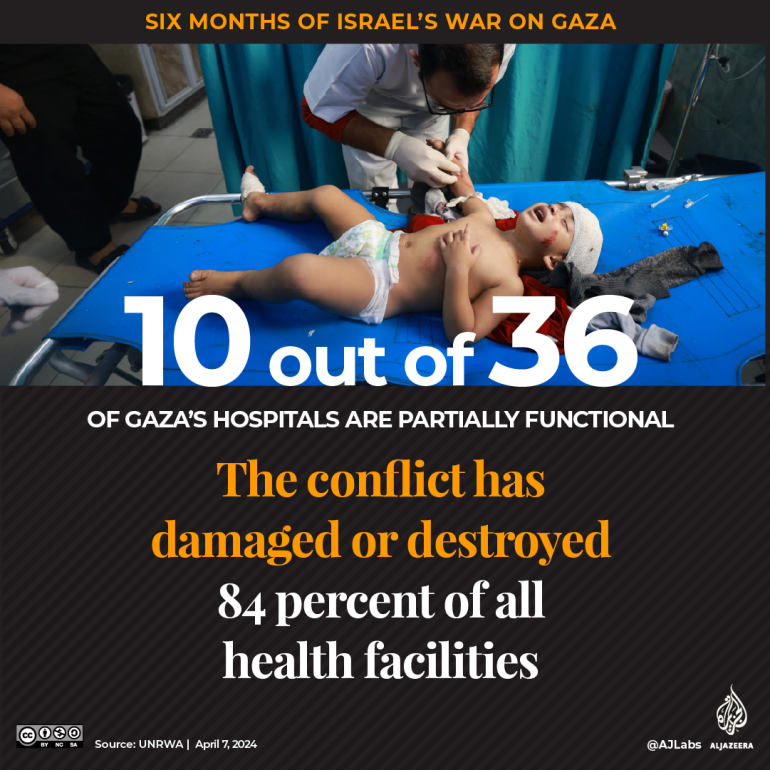
A two-week siege on Gaza's largest hospital, Al-Shifa, and its surrounding area left the hospital severely damaged and burnt down by last week. Israeli forces killed at least 400 people in the compound during the siege and arrested hundreds more.
Most patients in Gaza have no access to treatment due to exhausted and starving medical workers and severe shortages of medicines. Many surgeries and amputations had to be performed without anesthesia.
How many journalists were killed?
Israeli forces have killed more journalists and captured more than 24 people than any other modern conflict.
On March 18, Al Jazeera correspondent Ismail Al Ghoul was arrested and beaten for 12 hours by Israeli forces at Al Shifa Hospital.
Previously, on January 7, Al Jazeera reporter Hamza Dadou, the son of Gaza bureau chief Wael Dadou, was killed by an Israeli missile in Khan Yunis. Hamza was riding in a car near Al Mawashi with Mustafa Touraya, another journalist who was also killed in the attack.
On December 15, 2023, Al Jazeera cameraman Samer Abudaqa was attacked by an Israeli drone in Khan Yunis, Gaza Strip, and Wael Dadou was also injured.
Abdakah was unable to receive permission from the Israeli military and emergency personnel were unable to arrive, so he bled to death for more than four hours.
The Committee to Protect Journalists put the number of journalists killed at 90, and the Gaza Government Media Office said about 140 people were killed.
Last week, an Israeli attack targeted journalists' tents in the courtyard of Al-Aqsa Martyrs Hospital, killing at least four people and injuring several journalists.
